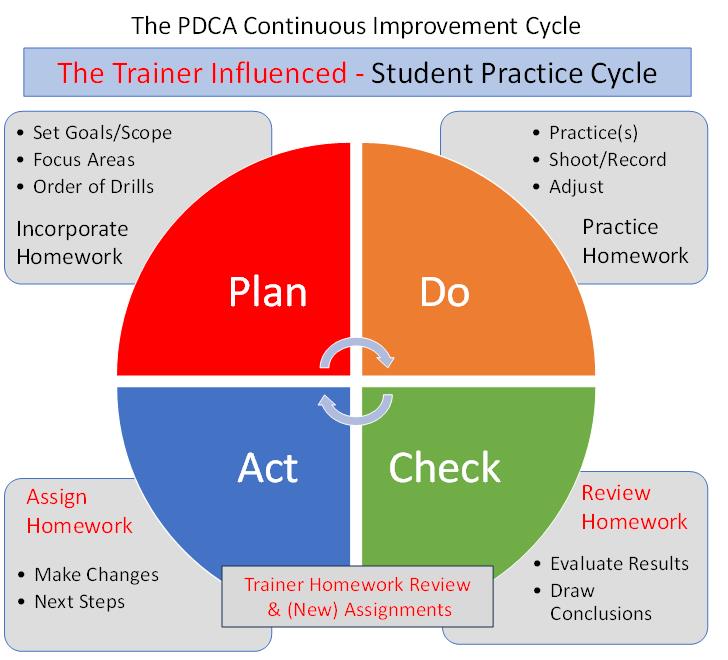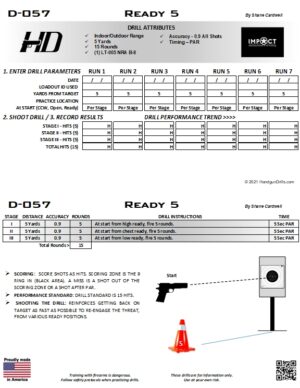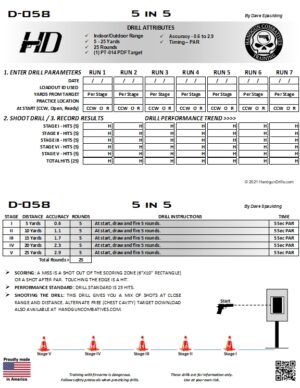See how the PDCA Continuous Improvement Cycle can help you create amazing practice (improvement) momentum to become a great student now! Apply these 4 steps in practice to accelerate your results to become a great student and possibly one of the best shooters in your group.
But time is of the essence….
If you think about practicing more than you practice – well, join the club. It’s true for me on many occasions because I get crazy busy, and time just flies by. If you want to make more progress with the practice time you have then this is for you. How about we build some Practice Momentum and become a really great student now?

So, if you want to become really good at concealed carry skills, or as good as you can with the time you have, then it only makes sense to become really good at practice right? After all, improving your practice takes skills of its own!
Let’s talk about making your practices as effective and focused as possible by applying the proven PDCA continuous improvement model for concealed carry practice. This means that as you practice to improve your shooting skills, you are also improving your practice approach. These build on each other to create real practice momentum.
The Power of the 4 Steps in the PDCA Continuous Improvement Cycle
The PDCA model is a well-established 4 step process for improving a process. Since shooting is a process, the PDCA cycle can be applied to improve your practice process. The truth is we all use this basic process to improve things whether we know it or not. However, the gold is revealed when we acknowledge it and engage it to master each of the 4 steps to create real practice momentum.
The HandgunDrills.com “The Trainer Influenced – Student Practice Cycle” show two steps highlighted where Trainers can have the most influence on, to the extent they are available. Trainer influence is presented in the form of Training Homework, which is an integral part of the Check and Act steps.
These 5 items are important to follow and have in place so that the continuous improvement approach is effective.
- You must be able to practice correct technique and know if its correct through proper training.
- Improving applies to both dry fire and live fire practice, as dry fire should be a significant amount of your practice time.
- Live fire can be used to practice drills or to use drills as “skill tests” and will verify dry fire practice progress.
- A Trainer is a critical part of the practice process and can have a dramatic impact on enhancing your practice skills.
- You are ultimately the only person that can own your practices and create real practice momentum.
The Four Steps of the Model: Plan-Do-Check-Act
The PLAN step is simply where you decide what your next practice will be focused on and what you will practice, usually on a skill or two.
The DO step is the actual dry fire practice in the basement or live fire practice at the range. During this practice time, you will make many small adjustments to your plan based on your observations and should make note of the significant ones.
The CHECK step is the overall review of the practice session results. Here you draw conclusions such as what worked or not, what improved or not, and so forth. If practice was a direct result of homework assigned from your Trainer, then your Trainer will likely want to review your results and conclusions as well. At least every so often. You will also need to meet personally with your Trainer so they can observe you directly. This provides invaluable input and will improve your practice momentum.
The ACT step is where you make decisions on what to do next. Here, based on your “check” conclusions, decide to do more of something, make changes, move on to try new skills and drills, refine techniques even further, etc. Your Trainer is invaluable on the Act step as well. Especially since most of us cannot watch ourselves practice and see what needs to be changed. So having a regular training session is critical to staying on track.
(For more information on the PDCA Cycle.)
So, to get good at practicing, guess what?
Yes, you must practice practicing.HandgunDrills.com provides a printable PDCA Practice Template to make it simple and easy to plan, organize and master each of these 4 steps of the improvement process.
Just try the Practice Plan Template for a while until you have the steps down. Then use the Log section in your Concealed Carry Book of Drills, or a simple notebook will do, to make some simple notes during each step as you through your practice routine. Keeping good notes is critical to remembering where you came from.
To have future tips and tools about Concealed Carry Practice sent directly to you don’t forget to sign up for our email newsletter and receive our List of Drills.
For more detailed information on the PDCA model please see the Student Portal. Or email questions or to let us know how you are doing, please contact us directly at HandgunDrills.com.
Please see the other articles in the series “Concealed Carry; Become a great student now!” as they become available at HandgunDrills.com.
HandgunDrills.com is dedicated to helping Concealed Carry Students “practice with a purpose, what they learn in training, from the skill level they’re at, with the time and ammo they have.” And to help Trainers stay connected to their Student’s practice.
Disclaimer: Every person and their circumstances are unique, so no single point of view is applicable to everyone. And everyone must decide what makes sense for them. Therefore, the thoughts, opinions and information in this post are for your consideration only to incorporate as you believe is appropriate.




0 Comments